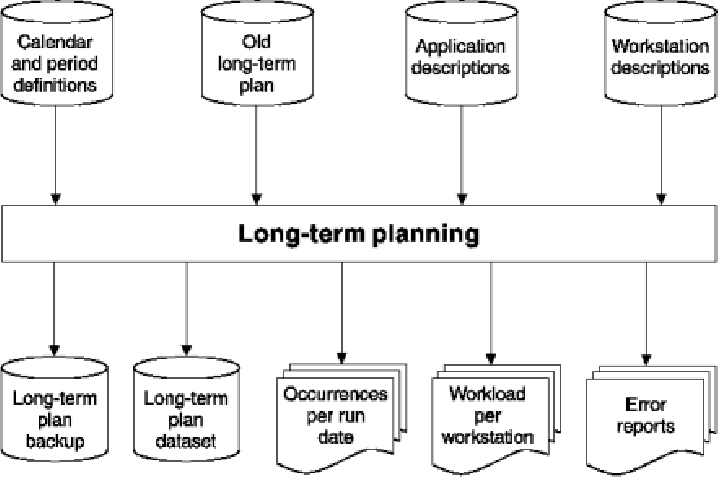Long-term plan
- The application description database
- Calendar and period definitions
- The current long-term plan, if one exists
When an application or job description is scheduled in the long-term plan or current plan, it becomes an occurrence. Every occurrence is uniquely identified by its name, input arrival date, and time.
HCL Workload Automation for Z examines every application and job description to determine if an occurrence should be generated in the long-term plan. An occurrence is generated if an active application has a run cycle with a period and calendar combination that falls within the long-term plan range. If an application or job description has been specified as belonging to a group definition, the run cycles and calendar definition are extracted from the group definition, and an occurrence group is created in the long-term plan. An occurrence group consists of application occurrences that reference a group definition and have the same input arrival date and time.
Occurrences from the old long-term plan that you have added, deleted, or changed manually are carried over to the new long-term plan, except when HCL Workload Automation for Z is creating a new long-term plan.
Production of the long-term plan describes the data required for the long-term planning process.

The long-term plan contains an occurrence entry for every planned run of an application. Most applications generate several occurrences in the long-term plan; for example, applications that are required daily or weekly. Every occurrence in the long-term plan is uniquely identified by the occurrence name, input arrival date, and time. The input arrival time is calculated from the run cycle defined to the application or job description or from the group definition if the application is a member of a group.
The long-term plan also contains external dependency information produced from data in the AD database. It does not, however, know the relationships between operations making up an application.
As time goes on, you must extend the long-term plan to cover future periods. For example, if you wanted to plan for 4 weeks, you could initially set up the long-term plan to cover a period of 35 days into the future. You could then extend the long-term plan by an additional 7 days every week. Your long-term plan would always stretch at least 28 days into the future.
When you create your long-term plan, you specify the start date. Although this information is recorded and shown as the long-term plan start date in the HCL Workload Automation for Z panel, occurrences are not maintained as far back as this date. If this were the case, the long-term plan data set would expand indefinitely. When you create a new current plan (NCP) part of the process is to update the long-term plan with any occurrences that are now eligible for removal from the current plan. For details, refer to Removing data from NCP by running daily planning.
The length of the long-term plan is calculated from the date of the earliest occurrence it contains, that is, from the date of the earliest uncompleted occurrence. The long-term plan length is not calculated from the long-term plan start date.
HCL Workload Automation for Z does not delete occurrences from the long-term plan that are uncompleted or any occurrences that follow an uncompleted occurrence. HCL Workload Automation for Z deletes occurrences on a day-by-day basis. That is, all occurrences—or none—are removed for a particular day. This means that if you have occurrences in your long-term plan that are not completed, all occurrences scheduled for that day and all following days are retained, whether the occurrences are completed or not. As part of HCL Workload Automation for Z maintenance, you should assess such uncompleted occurrences and take suitable action. For example, you can manually mark the occurrences as complete, or delete the occurrences if they are not required. This saves space in the VSAM data set that the long-term plan is stored in and reduces the time and resources required to perform long-term plan batch and panel functions.
The long-term plan contains run time and external dependency information for application occurrences. The current plan, which is the HCL Workload Automation for Z detailed schedule, is based on the occurrence information stored in the long-term plan.